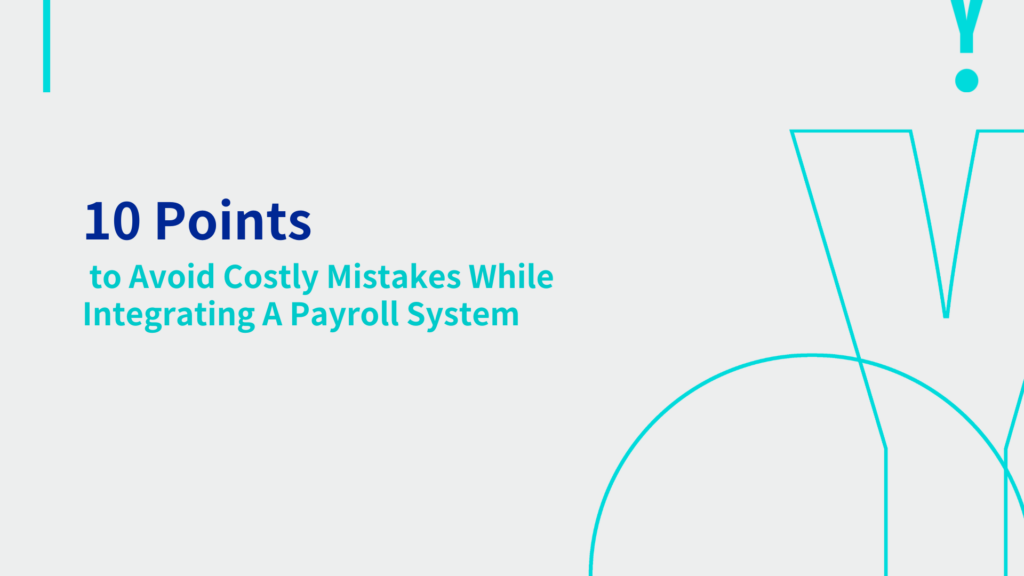
Every business today relies heavily on seamless payment systems for smooth operations and satisfied customers. However, payment integration is often challenging.
Businesses frequently face technical delays, hidden costs, compliance challenges, or poor customer experiences while implementing payment solutions. These mistakes become extremely expensive.
Therefore, choosing the right strategy before integrating a payroll management system is absolutely essential for sustainable business growth and efficiency. Therefore, by carefully understanding integration requirements, businesses can prevent security risks, unnecessary fees, and payment failures that hurt long-term trust and revenue.
This blog highlights ten crucial points businesses must consider. Following them helps avoid costly mistakes while ensuring flawless payment processing that drives better business outcomes.
- Why Avoiding Payroll Integration Mistakes Matters for Businesses?
- 1. Clearly Understand Your Business Payment Needs
- 2. Research Payment Processing Providers Thoroughly
- 3. Evaluate Security & Compliance Standards
- 4. Ensure Seamless Integration with Existing Systems
- 5. Analyze Total Cost beyond Transaction Fees
- 6. Prioritize User-Friendly Customer Experiences
- 7. Plan for Scalability And Future Growth
- 8. Test System Performance under Different Scenarios
- 9. Provide Adequate Staff Training And Support
- 10. Monitor & Optimize Continuously after Integration
- End Note
Why Avoiding Payroll Integration Mistakes Matters for Businesses?
Before diving into specific points, it’s important to understand why avoiding mistakes during payment integration holds such significance for businesses. Every payment failure directly impacts customer trust. Once trust is lost, businesses face challenges in regaining confidence and building lasting relationships.
Additionally, costly technical errors and hidden fees can erode profit margins, making even strong sales performances less effective. Poorly planned integrations also increase operational inefficiencies. Employees waste time fixing recurring issues instead of focusing on growth-oriented initiatives.
Moreover, compliance failures invite penalties and legal consequences, which further damage brand reputation in competitive markets.
Therefore, businesses must proactively identify risks early. By doing so, they create smoother financial operations, happier customers, and stronger long-term growth opportunities.
1. Clearly Understand Your Business Payment Needs
Firstly, businesses must define payment requirements before choosing any system. Many organizations fail by skipping this crucial evaluation process.
For instance, some businesses primarily need recurring payments for their payroll system, while others focus on international transactions. Each case requires different features.
Therefore, you should list your priorities, whether mobile wallets, multiple currencies, or subscription billing. This clarity helps choose the right provider.
Additionally, understanding customer expectations is equally important. If they expect multiple payment options, ensure your system fully supports them. Without this clarity, businesses risk paying for unused features while missing essential ones that directly impact customer satisfaction.
2. Research Payment Processing Providers Thoroughly
Secondly, research is critical. Many businesses rush into decisions and later regret being locked into unsuitable long-term contracts. You must evaluate different providers’ reputations, success stories, and client reviews. A provider’s track record directly indicates service quality.
Additionally, businesses should request case studies from providers. This provides insights into their ability to handle businesses similar to yours. Cost comparison is also necessary. Providers may advertise low fees but add hidden charges later, causing financial strain.
Furthermore, check how responsive their customer support is during the payroll integration. Poor support often leads to unresolved issues and losses.
3. Evaluate Security & Compliance Standards
Security breaches and compliance failures are costly. Therefore, businesses must prioritize payment providers that meet top security certifications and regulations.
For example, ensure the provider complies with PCI DSS standards. This guarantees secure handling of sensitive cardholder information.
Additionally, consider fraud detection features. A strong fraud management system prevents unauthorized transactions and minimizes disputes or chargebacks. Moreover, compliance with regional regulations like GDPR or local banking laws is equally vital for businesses handling international customers.
Ignoring compliance leads to penalties, reputational damage, and customer distrust. Secure integration builds long-term credibility while preventing costly breaches.
4. Ensure Seamless Integration with Existing Systems
Another major point involves compatibility. Businesses often face problems when payment systems fail to integrate smoothly with existing applications or platforms. You must confirm whether the payment solution connects effectively with ERP, accounting, or e-commerce platforms already in use.
Additionally, consider API availability and ease of use. Well-documented APIs reduce developer time and enable faster, smoother integration. Moreover, integration testing should be done before launch. Testing identifies bugs early, preventing payment disruptions after going live.
When systems fail to integrate properly, employees waste time on manual reconciliation, leading to errors and frustrated customers.
5. Analyze Total Cost beyond Transaction Fees
Many businesses make the mistake of only comparing transaction fees while ignoring additional costs. This leads to unpleasant financial surprises. Therefore, you must ask providers about setup costs, monthly maintenance fees, chargeback penalties, or cross-border transaction charges.
Hidden costs significantly impact profitability, especially for businesses with high transaction volumes. Accurate cost calculation ensures better budgeting and decisions. Additionally, always request a transparent breakdown of pricing. Providers unwilling to share details usually hide fees that hurt businesses later.
Thus, a complete cost evaluation prevents budget overruns while ensuring your integration truly supports business growth.
6. Prioritize User-Friendly Customer Experiences
Customer experience drives payment success. Complicated checkout processes often result in cart abandonment and lost sales opportunities. Therefore, businesses must ensure their chosen payment solution offers simple, intuitive, and quick experiences across all devices and platforms.
Features like one-click payments, mobile-friendly interfaces, and guest checkout options directly improve customer satisfaction and conversion rates.
Additionally, offering multiple payment methods in the payroll, like credit cards, digital wallets, and net banking, empowers customers to pay conveniently. Therefore, focusing on usability not only improves immediate revenue but also builds loyalty for long-term relationships with customers.
7. Plan for Scalability And Future Growth
Business growth demands flexible systems. Unfortunately, many companies select providers that cannot scale effectively when transactions increase. Therefore, check whether the payment processor supports higher transaction volumes without downtime. Scalability ensures future expansion without switching providers.
Additionally, explore whether the provider supports international payments. Businesses aiming for global reach must ensure currency conversion and cross-border support. Moreover, technological advancements like contactless payments or blockchain integration might become relevant. Your system must adapt without complete reinvestment.
By planning scalability early, businesses avoid disruptions and additional expenses while expanding successfully in competitive markets.
8. Test System Performance under Different Scenarios
Performance issues frequently cause costly mistakes. Businesses should always test payment systems thoroughly before full implementation.
For instance, simulate high transaction loads to check whether systems handle peak demand without failure or delays.
Additionally, perform security penetration testing to confirm systems resist cyberattacks. This testing ensures the long-term safety of sensitive financial data. Moreover, test different customer payment scenarios. For example, failed transactions, refunds, or expired cards must be handled smoothly.
Thorough testing of a payroll system prevents system crashes, frustrated customers, and revenue losses during critical business periods.
9. Provide Adequate Staff Training And Support
Even the best systems fail without knowledgeable staff. Businesses must invest in training employees before launching payment integrations. Training ensures employees understand reporting dashboards, reconciliation processes, and troubleshooting procedures. Without this, mistakes increase and service quality declines.
Additionally, establish a dedicated support team to manage payment-related issues. Quick responses reduce downtime and improve customer experiences. Furthermore, businesses must prepare escalation plans for emergencies. Clear procedures help minimize losses during unexpected system failures.
Investing in people ensures smooth operation while protecting businesses against costly inefficiencies.
10. Monitor & Optimize Continuously after Integration
Finally, integration is never a one-time task. Businesses must regularly monitor performance to identify opportunities for improvement. Analytics dashboards provide valuable insights into transaction success rates, abandoned carts, and fraud attempts. These critical insights drive better business strategies.
Moreover, request regular updates from providers. New features or security patches often enhance functionality and reduce long-term risks. Additionally, businesses should periodically renegotiate contracts. Payment volumes may increase, giving leverage for better pricing and improved terms.
Ongoing optimization ensures businesses remain competitive, efficient, and profitable while avoiding mistakes that accumulate costly consequences over time.
Now, if you want to integrate a custom payroll system in your office, visit YOOV.
End Note
Integrating a payroll or payment processing system is critical but challenging. Mistakes create hidden costs, compliance risks, and customer dissatisfaction that businesses cannot afford. By carefully evaluating needs, researching providers, ensuring security, testing thoroughly, and planning for scalability, businesses avoid expensive integration pitfalls.
Furthermore, prioritizing customer experiences and continuous optimization helps build trust and revenue growth. Businesses must treat payment integration as a strategic investment. Ultimately, these ten points guide organizations toward seamless integration, minimizing risks while maximizing financial and operational efficiency for sustainable success.
Connect with YOOV

WhatsApp:Click Here
Email:hello@yoov.com
Website:https://www.yoov.com/